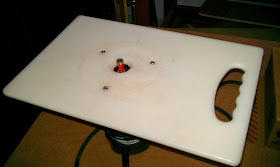Life will be much more fun with a proper insert, or something like it. A lot of the cutters that need to be used in a table are big ones - they're fairly wide, and usually you need quite a lot down below the level of the table. So having a small hole, through which the collet fits, doesn't do the job. You also need to be able to spanner the collet easily for cutter changes.
The cutting board thing is a really good idea. There's no reason why you shouldn't trim it down to, say, a 6" square, and let that into the bench top. Instead of inserts, have different sized holes (in different squares, to suit the cutters you're using), and a completely blank one for when you're not using the router at all. I'd be amazed if a cutting board didn't work really well as material for that purpose.
The only things that would possibly frustrate me with that arrangement would be three:
- how you arrange a fence,
- dust extraction,
- the need to leave it set up.
I couldn't get by without an easily adjustable fence. Mine is a commercial one that splits in the middle, which is an unnecessary complication.
All you really need of any fence is to be able to hold it down solidly (no slipping), and to be able to move it in small, precise amounts. Clamping a long straight block of wood to the bench is easily good enough (needs a hole for the cutter, obviously), and, although you need good vertical height and stiffness for machining panels etc., you can do a lot with just a good quality bit of 3x2 (and that hole!).
Micro adjustment? I mostly use plastic wedges, the sort used by window fitters, as they're available in 1mm thickness increments. That gives you 0.5mm adjustment easily if you pivot the fence at one end, and better than that if you position them asymmetrically.* Clamp a block solidly behind the end of the fence, and put the wedges in between that and the back of the fence itself. It works really well when you need to take small bites out of something: set it up to work at the finish depth on scrap, then add back, say 6mm of wedges that you can progressively remove with each pass over the cutter.
Operations like rebating make a lot of mess very quickly. Never mind health implications, there's the matter of being able to see what you're doing and not getting rubbish stuck under stock you're trying to exactly machine.
In my experience, dust extraction doesn't get loads better with the purpose built shields - as long as you have lots of 'suck' and can get the vacuum cleaner nozzle close enough (at the back),
and hold it securely, it will do well enough.
Radical thought: if you have the Nilfisk/Numatic ("Henry") sized hoses you can "make" custom extractors simply be sacrificing a nozzle by carving it to shape to fit closer to the cutter. Vac shops sell a male-to-male short plastic adaptor cheaply that's ideal for this, and "crevice tools" might do, too. If the nozzle hits the cutter in use, it's not a disaster as such, but it will make you jump - not a good thing - so make sure it IS well secured.
The only real nuisance value you can't easily overcome is the need to leave the table set for long periods of time:
Imagine you're doing panel doors and machining the rails and stiles: You might well want to leave the table set, in case something gets damaged and you need to make a replacement. That's hard when it's also your main workbench!
For that last point there's no easy fix I can see (although I guess you might lift out router+plate and drop it gently back in place when you needed to - it would save
some setup time I suppose).
Otherwise. persevere with the idea: I bet you can make it work well.
E.
*simple maths: if you pivot the fence at one end and the cutter is 1/4 of the way along from the pivot, then 1mm movement at the far end will move the fence in or out by 0.25mm at the cutter. That's good enough for many, many purposes! The overall fence length theoretically makes no difference (it's the ratio of distances along the fence that do), but it works more smoothly with longer fences. I get good results with a fence that's about 3ft overall.


































